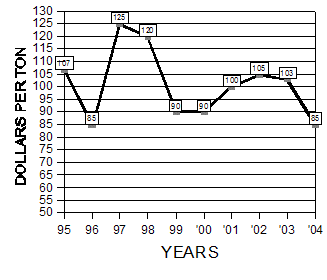Alfalfa Report
Yuma County, Arizona
January 26, 2004
Yuma County Office
2200 W. 28th Street, Ste. 102
Yuma, AZ 85364
(928) 726-3904
(928) 726-8472 FAX
Production Update:
Frost Damage: Frost-damaged alfalfa has lower quality
due to leaf loss, lower digestibility, and decreased mineral content.
Frost-damaged alfalfa may also accumulate toxic levels of nitrates in
rare cases. Water application during freezing temperatures can raise the
temperature, but waterlogging can produce negative effects. In the case
of alfalfa, the best protection against frost is a healthy crop. Severe
frosts can kill the tops of the alfalfa plant and new growth must occur
from the base of the plant. Cutting alfalfa after a frost can stimulate
this new growth near the base of the plant, but the new growth is then
susceptible to subsequent frosts.
Insect Management: Cowpea aphid (picture)
is a serious pest of alfalfa that can warrant treatment with an insecticide
when populations are growing rapidly. Cowpea aphid is attacked by several
predators (bigeyed bugs, damsel bugs, lacewings, lady beetles, and syrphid
fly larvae) and parasites. Aphid parasites, Lysiphlebus sp.(
picture)
and Diaraetiella sp. (
picture)
have been reared from cowpea aphid mummies collected from both the high
and low desert. Populations of sevenspotted lady beetle, Coccinella
septempunctata (
picture)
and aphid parasites often build to levels capable of controlling cowpea
aphid in alfalfa fields not sprayed with insecticides.
Weed Control: Trifluralin (Treflan) binds strongly to the soil and will last for 3-6 months on well drained soil. February is not too early to apply it for control of summer weeds. Eptam, on the other hand, moves readily with water and does not last long followed by multiple irrigations. February may be too early to apply it for summer weed control.
| Market Summary |
High
|
Low
|
Average
|
Off grade
|
| Past 2 Weeks (Jan 13 - Jan 26, 2004) |
90
|
70
|
85
|
60-70
|
| Last Year (Jan. 13 - Jan 26, 2003) |
105
|
95
|
103
|
70-90
|
10 Year Summary (Jan 13 - Jan 26, 1995-2004):

Issued in furtherance of Cooperative Extension work, acts of May 8 and June 30, 1914, in cooperation with the U.S. Department of Agriculture, James A. Christenson, Director Cooperative Extension, College of Agriculture and Life Sciences, The University of Arizona.
The University of Arizona is an equal opportunity, affirmative action institution. The University does not discriminate on the basis of race, color, religion, sex, national origin, age, disability, veteran status, or sexual orientation in its programs and activities.
Any products, services, or organizations that are
mentioned, shown, or indirectly implied in this web document do not imply
endorsement by The University of Arizona.
Information provided by:
Barry Tickes, btickes@ag.arizona.edu Extension Agent, Yuma County
Michael Ottman, mottman@ag.arizona.edu Agronomy Specialist
College of Agriculture, The University of Arizona.
Eric Natwick, etnatwick@ucdavis.edu UCCE Imperial County - Farm Advisor
University of California, Davis, CA.
Forages: Crop Mgmt | Soil Mgmt | Irrigation | Alfalfa Reports | Insects | Diseases | Weeds | Pesticides
Home | Other Crops | Forages
For more Arizona Production Ag Information:
Home | Cotton | Veggies| Forages | Grains | Citrus | Crop x Crop | Insects | Diseases| Weeds | Pesticides | News | Weather | Research | Photos | Contacts | General Info. | Site Map
Copyright © 2001 University of Arizona,
College of Agriculture and Life Sciences
Webmaster: Al Fournier (fournier@ag.arizona.edu)